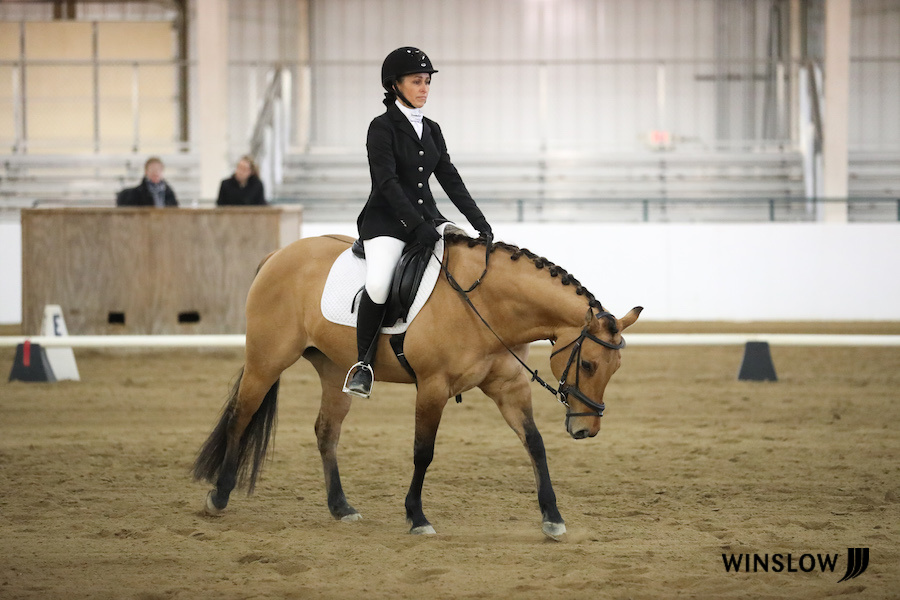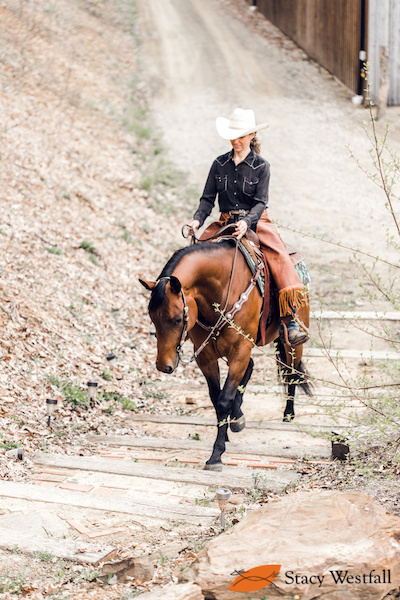Example of ‘Looking down through the bridle” shown by Stacy Westfall and her mare Gabby
“Stacy, How can I teach my horse to reach his neck down and out for the free walk?”
Free walk, stretchy walk, long and low…no matter what riders call it the idea is the same. The horse should lower and stretch the neck downward and outward.
To be more specific, western dressage defines the free walk as:
WD 103 The Walk
3.c. Free Walk. A relaxed walk with unconstrained, forward reaching steps where hind feet touch the ground clearly in front of the footprints of the forefeet. The horse must be relaxed and be allowed complete freedom to lower his head and neck to stretch forward and down and out. The length of stride, rhythm, the relaxation and swing through his back are of great importance.
Similarly, traditional dressage defines the free walk as:
DR103 The Walk
3.d. Free Walk. The free walk is a pace of relaxation in which the horse is allowed complete freedom to lower and stretch out his head and neck. The degree of ground cover and length of strides, with hind feet stepping clearly in front of the footprints of the front feet, are essential to the quality of the free walk.
I’ve been showing in both traditional dressage as well as western dressage so it is nice that the definitions are so similar.
Here is my approach to teaching the free walk, which later transitions to the free jog.
Step 1-teach the horse to accept light contact on the reins at all gaits.
Tips: If your horse is resistant, check these three things:
- Are his teeth in need of dental care?
- Do you need to go to less bit? (I prefer a snaffle for this exercise)
- Are your hands following the motion of the horse? At the walk and lope, the horses head has a slight bobbing motion. Your contact should reflect this.
Step 2-ride a spiral-in and spiral-out circle with an awareness of the horses head
Tips: Make your small circle about 10 meters and spiral out to 20 meters while keeping the bend to the inside. You should notice:
- How does your horse respond when you begin to spiral out? Does he raise or lower his head?
- How does your horse respond when you begin to spiral in? Does he raise or lower his head?
- Does this change if you add more bend?
Step 3-RECOGNIZE when your horse is ‘looking down through the bridle’
Tips: To visualize your horse looking ‘down through the bridle’ imagine riding over something he finds curious while lightly holding contact. I find that simply riding over a log will encourage many to ‘look down through the bridle.’
Step 4-SOFTEN your contact when the horse is ‘looking down through the bridle’
Tips: Now that you have recognized the feel, repeat the spiral-in and spiral-out circle exercise. When you notice the horse ‘looking down through the bridle’ soften your contact. Note: I prefer softening the contact to dropping the contact…play with both ideas and see what works for you.
Step 5-end your work session with free walk
Tips: A horse at the end of a work out is often more willing to stretch. Fresh horses are more challenging so I begin training this at the end of my rides. Soon the horses catch on and begin offering it earlier and earlier in the ride.
Some final thoughts…
This movement can help riders improve their communication with their horses. It is key for developing an elastic type feel that will translate into a rider with better hands and a confident horse.
When riding, keep in mind that your seat and body should also keep the movement of the walk. Often riders become fixated on their hand positions and forget to swing their hips and keep the rest of their body ‘riding’ the horse. If in doubt, video yourself for 2 minutes and review. If you become stiff while learning a new technique…your horse will reflect this.
I personally teach my horses to reach ‘into contact’ which means that I hold a light contact as the horse reaches. I have two reasons for this. First, in traditional dressage, this is required during the stretch at the trot. Second, I don’t want my reining horses dropping their heads abnormally low when I give them a loose rein. By asking them to stretch into contact I can separate my cues for the different events.
If you have questions, feel free to ask them in the comments!

Stacy Westfall and her mare Willow (who is also a reining horse) showing in dressage
Have you seen my YouTube series on western dressage? Check it out here: Stacy’s YouTube.
Here are some of the videos already posted:
2 Comments
Leave a Comment

FREE PDF DOWNLOAD
WHY IS MY HORSE...?
100% Private - 0% Spam
No one taught you the skills you need to work through these things.
Riders often encounter self-doubt, fear, anxiety, frustration, and other challenging emotions at the barn. The emotions coursing through your body can add clarity, or can make your cues indistinguishable for your horse.
Learning these skills and begin communicating clearly with your horse.
Click here to learn more.


Great article! My horse naturally likes to go long and low and enjoys the stretch of the free walk. We incorporate it into almost all of our rides. Our WD free walk scores have been between 6-6.5 with the constant comment that she needs more swing in the back. My question is-how do I get my horse to understand that the free walk is still an active move vs. just a stretch or “break time.”
Interesting article, are there any other articles by Stacy online!